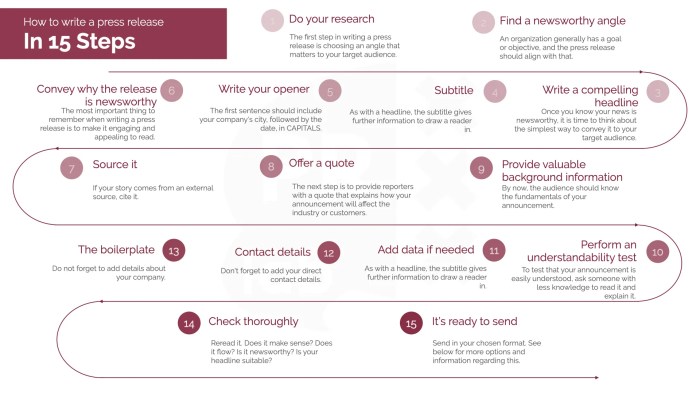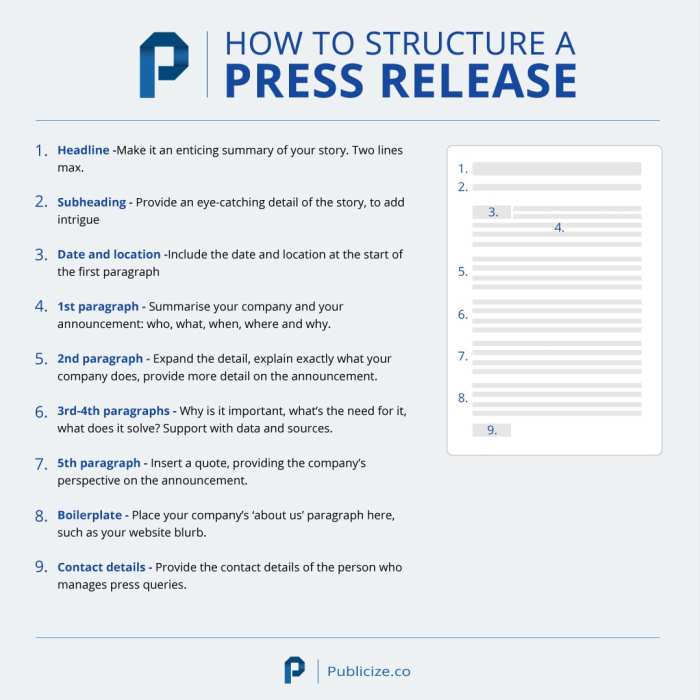Creating a Press Release Strategy dives into the key elements of crafting effective press releases, providing insights and tactics to enhance your communication efforts in a dynamic and ever-changing media landscape. The importance of a strategic approach to press releases cannot be overstated in today’s fast-paced world of information dissemination.
As we explore the various facets of developing a successful press release strategy, you’ll uncover valuable tips and best practices to elevate your messaging and engage your target audience effectively.
Introduction to Press Release Strategy

In today’s fast-paced digital world, having a well-defined press release strategy is crucial for businesses to effectively communicate their message to the public and media. A strategic approach ensures that press releases are not only distributed but also received and understood by the right audience.
Importance of a Press Release Strategy
A well-crafted press release strategy serves as a roadmap for companies to navigate the ever-changing media landscape. It helps in building brand awareness, establishing credibility, and generating media coverage. Additionally, a clear strategy ensures that key messages are effectively communicated to the target audience.
- Identifying key objectives and goals for press releases
- Defining target audience and media outlets
- Creating a timeline for press release distribution
- Developing key messages and story angles
- Measuring the success of press releases through analytics
Research and Target Audience
Research plays a crucial role in developing a successful press release strategy. It helps in understanding the market, identifying key trends, and tailoring the message to resonate with the target audience. Without proper research, a press release may miss the mark and fail to achieve its objectives.
To define the target audience for a press release, it is essential to conduct thorough research on demographics, interests, behavior, and preferences. This information helps in creating a message that speaks directly to the intended recipients, increasing the chances of engagement and conversion.
Importance of Audience Research
- Audience research allows you to tailor your message to specific demographics, ensuring relevance and effectiveness.
- Understanding your target audience helps in choosing the right channels and timing for maximum impact.
- Researching audience preferences and behavior can guide the tone and style of the press release, making it more appealing to readers.
Tools and Methods for Conducting Audience Research
- Utilize Google Analytics to gather data on website visitors and their demographics.
- Conduct surveys and focus groups to gain insights into audience preferences and opinions.
- Use social media analytics to understand the interests and behavior of your followers.
- Explore market research reports and industry studies for broader insights into consumer behavior.
Crafting Compelling Press Releases

Crafting a compelling press release is crucial for grabbing the attention of journalists and the public. Here are some tips for creating engaging and newsworthy press releases:
Tip 1: Focus on the News Angle
When writing a press release, make sure to focus on the most newsworthy aspect of your announcement. Highlight what makes your story unique and why it matters to your target audience.
Tip 2: Keep it Concise and Clear
Keep your press release concise and to the point. Use clear and easy-to-understand language to convey your message effectively. Avoid jargon or unnecessary technical terms.
Tip 3: Include Quotes and Multimedia, Creating a Press Release Strategy
Adding quotes from key figures in your organization can add credibility and human interest to your press release. Including multimedia like images or videos can also make your release more engaging.
Tip 4: Write a Strong Headline
Craft a headline that is attention-grabbing and summarizes the main point of your press release. Make sure it is clear, concise, and compelling to entice readers to learn more.
Tip 5: Provide Contact Information
Always include contact information for a media representative in your press release. This makes it easy for journalists to reach out for further information or interviews.
Tip 6: Proofread and Edit
Before sending out your press release, make sure to proofread and edit carefully. Check for any grammatical errors or typos that could detract from the professionalism of your release.
Remember, a well-crafted press release can help generate media coverage and raise awareness about your organization or event. By following these tips, you can increase the chances of your press release getting noticed and making an impact.
Distribution Channels and Timing
In the world of press release distribution, choosing the right channels and timing is crucial to ensure maximum impact and reach for your message. Let’s delve into the different distribution channels available and the significance of timing in getting your press release out there effectively.
Different Distribution Channels for Press Releases
When it comes to distributing your press release, you have a variety of channels to choose from. Some common options include:
- Newswires: Distributing your press release through newswires can help you reach a wide audience of journalists, bloggers, and news outlets.
- Email: Sending your press release directly to journalists, editors, and influencers via email can allow for a more personalized approach.
- Social Media: Sharing your press release on platforms like Twitter, LinkedIn, and Facebook can help amplify your message and reach a broader audience.
- Company Website: Posting your press release on your company’s website ensures that it is easily accessible to anyone visiting your site.
Choosing the right distribution channels can help you target the right audience and maximize the impact of your press release.
Significance of Timing in Press Release Distribution
Timing is everything when it comes to press release distribution. Factors to consider include:
- Relevance: Distribute your press release at a time when your news is most relevant and likely to gain attention.
- Industry Events: Timing your press release around industry events or conferences can help increase visibility and engagement.
- News Cycles: Be mindful of news cycles and avoid distributing your press release during times when major news stories may overshadow your message.
Timing your press release strategically can help ensure that it gets the attention it deserves and reaches the right audience at the right time.
Tailoring Press Release Distribution
To tailor your press release distribution based on your target audience and goals, consider:
- Demographics: Identify the demographics of your target audience and choose distribution channels that align with their preferences.
- Goals: Determine the goals of your press release (e.g., brand awareness, product launch) and select distribution channels that align with those objectives.
- Engagement: Choose distribution channels that will allow for maximum engagement with your target audience, whether it’s through social media, email, or traditional media outlets.
Measuring Success and Optimization: Creating A Press Release Strategy
When it comes to measuring the success of a press release strategy, there are key metrics that can help you evaluate its effectiveness. Analyzing data and optimizing future press releases based on these metrics is crucial for improving your strategy over time. A/B testing can also provide valuable insights into what works best and how to refine your approach for better results.
Key Metrics for Measuring Success
- Media Coverage: Measure the number of publications that pick up your press release and the reach of those publications.
- Website Traffic: Track the increase in website visits following the release to gauge interest and engagement.
- Social Media Engagement: Monitor likes, shares, comments, and mentions on social media platforms to assess the impact of your press release.
- Lead Generation: Evaluate the number of leads generated as a result of the press release to measure its effectiveness in driving conversions.
Analyzing Data and Optimization
- Utilize analytics tools to track and analyze the performance of your press releases, identifying trends and areas for improvement.
- Compare data from different press releases to identify patterns and determine what resonates best with your target audience.
- Optimize future press releases based on insights gained from data analysis, adjusting messaging, timing, and distribution channels as needed.
Tips for A/B Testing and Refining Strategies
- Test different headlines, calls-to-action, or distribution channels to see which variations yield the best results.
- Experiment with timing and frequency of press releases to determine the optimal schedule for reaching your audience.
- Collect feedback from stakeholders and incorporate suggestions for improvement into future press release strategies.